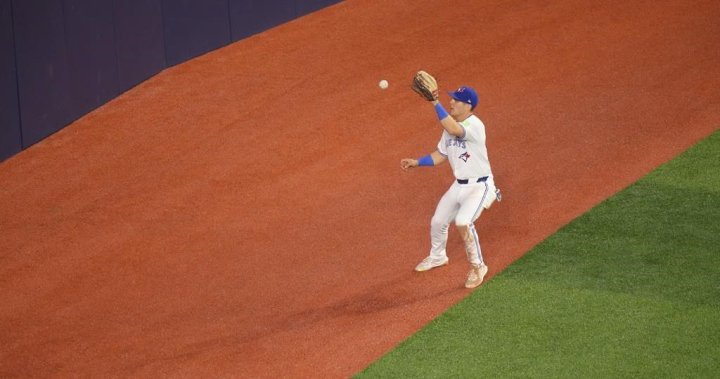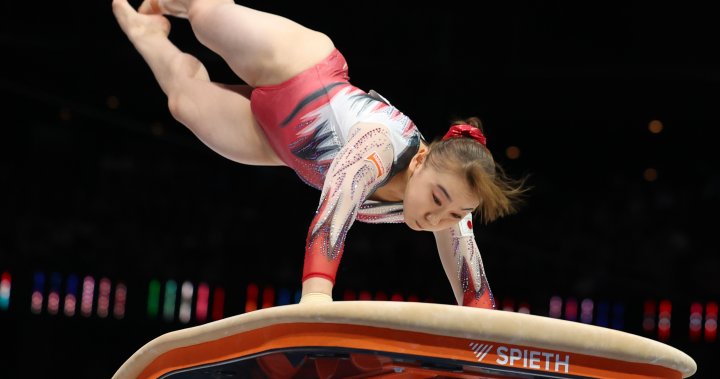TORONTO – Daulton Varsho loves to go all out when tracking down a fly ball but the new smaller foul areas at Rogers Centre have him being a little more cautious.
The Toronto Blue Jays completed the second phase of $400 million renovations to their downtown ballpark in the off-season, with the changes designed to improve the fan and player experience as the stadium becomes a baseball-specific venue. But the renovations altered the field’s dimensions, with 2023’s Phase 1 bringing in the outfield walls and making them higher and then the foul areas were shrunk ahead of this season as part of Phase 2.
Part of shrinking the foul territory was building higher walls in the outfield parallel to the first- and third-base lines.
“It’s a little dangerous just because you have to know if you’re gonna go into that wall how to collide with it,” said Varsho, who typically plays in left field. “It happened to me the other day where if you go into the wall with your feet, there’s a good chance of spraining your ankle or hitting a really bad spot
“You almost have to slide and then move your body so your body takes the hit into the wall.”
Phase 1 focused on redoing the stadium’s upper bowl and creating new fan zones, but as part of that the left-centre field was brought in by seven feet to 368 feet but the wall’s height went up to 11 feet, two inches. The right-centre field wall moved up 16 feet to 359 feet and its height was raised to 14 feet, four inches high.
The second phase reduced foul territory by about 3,000 square feet and walls were put in that run alongside the foul lines where previously there were low stands where outfielders could lean into — sometimes into the laps of fans — to grab a foul ball. Installing those side walls and narrowing the foul territory has changed how outfielders like Varsho run to the ball.
“Balls hit coming down there, they’re gonna hug that wall so it’s like you almost have to play goalie and be able to stop it,” said Varsho, noting it’s no longer possible to run a curving route toward the ball, getting square to home plate for a more stable catch. “There’s no being able to get around it and coming through it anymore.
Related Videos
“It’s just about being able to know what you need to get out there and be able to get to those baseballs.”
The email you need for the day’s
top news stories from Canada and around the world.
Davis Schneider, who plays in left field when Varsho is in centre, said the new dimensions are something he’s had to adapt to in Toronto’s 15 home games this season.
“It’s such a short foul territory, you can’t run as hard into the wall or you have to make sure you play it differently than what you used to,” said Schneider. “Balls down the line, they’re not really going to kick out anymore, they’re either going to hit that wall and shoot back to the shortstop or they’re going to keep going to the wall so you have to play balls differently.”
Help from the infield is a necessity, with the sharp corners and shorter distance to home making it possible for a hard-hit ball to ricochet back into the shallow part of the outfield. A shortstop has to move toward the outfield on a line drive to left field and, depending on where the baserunners are, the first or second baseman has to move toward right field to back up their corresponding outfielders.
“You don’t really have a lot of space so anything down the line, you have to still make that angle,” said right-fielder George Springer. “The only big difference is I rely on (all-star first baseman Vladimir Guerrero Jr.) and whoever’s playing second just because of the little corner, because I have to angle myself to go toward the wall.
“If the ball hits off that edge I need somebody else to get there but, other than that, it’s all the same.”
Utility infielder Isaiah Kinfer-Falefa, who had played at third base 18 times in 31 games for the Blue Jays this season, said he thinks Rogers Centre is now playing more like one of baseball’s cathedrals: Boston’s Fenway Park.
“It’s kind of similar to how you play the kick-off in Boston, it’s very similar,” said Kiner-Falefa. “But I enjoy it as a hitter. With less foul ground it helps a lot.
“It’s just something where the home team could take advantage if we understand how to play that ball off the wall.”
Although the Blue Jays have only had 15 home games so far this year — less than 10 per cent of the total season — there is some statistical evidence that the new dimensions have changed what kind of hits are prevalent at Rogers Centre.
Baseball Savant is an online resource maintained by Major League Baseball that tracks granular data on every pitch, swing and play throughout the season.
That includes park factors, a stat that compares every MLB stadium on different statistics like singles, extra-base hits, home runs, strikeouts, runs, and more complex stats like BACON (batting average on contact, including home runs). A park factor score of 100 means the stadium is average compared to all the other ballparks in the league. A higher number means it has a higher frequency of that stat than other venues and a lower number means it’s a more rare occurrence.
Baseball Savant has park factors data for Rogers Centre dating back to 1998 when it was still called SkyDome. The website is only missing numbers from 2020 when no MLB games were held in Toronto because of the COVID-19 pandemic.
Historically, Rogers Centre has been a home-run hitters’ park, with a park factor score at or above average 19 times between 1998 and 2022. But after the walls were moved in and heightened in 2023, its rating dropped to 95. It currently has a 94 home-run park factor this season.
Singles, however, are significantly more commonplace.
In the 26 seasons Baseball Savant tracks park factor, Rogers Centre has only been above average for singles three times, reaching a modest score of 101 three times (2004, 2005, 2022). So far this season, it’s at an all-time high of 111. Hits in general are also up, with a current park factor rating of 109, four points higher than the previous high of 105 in 2003.
New artificial turf was installed during the off-season renovations after the previous field was ripped out when the demolition process started last fall. Kinfer-Falefa thinks the new turf may have something to do with the increased frequency of base hits.
“I always enjoyed my time hitting here as a visitor so being able to play here and the foul dimensions, smaller, bringing the fences in, it definitely helps a lot,” said Kiner-Falefa, adding that Rogers Centre’s turf is one of the reasons he signed with the Blue Jays in the off-season. “I feel like sometimes outfielders lay back to make sure the balls don’t get over their head so they’re not as aggressive on those fly balls, on the coming in on those shallow fly balls and a lot of balls are out of play instead of being caught.”
This report by The Canadian Press was first published May 2, 2024.






